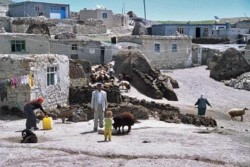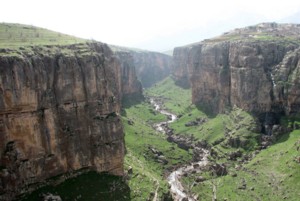Kurdish (also: Kurmanji, Bahdini, Sorani)
Kurdish :: Language-genetic affiliation
Kurdish is a Northwest Iranian language (and as such affiliated to the Indo-Iranian branch of the Indo-European language phylum), related most closely to Persian and transitional varieties spoken along the Iraq-Iran border, such as Hawrami, Gurani, Luri and others, as well as to Dimli (Zazaki), which is spoken in dispersed communities within the Kurdish-speaking areas. The northern varieties of Kurdish are known as Kurmanji (and in Iraq as Bahdini), those spoken in the south of the region are known as Sorani. The dividing line is situated roughly between the towns of Mosul and Rawandiz to the north, and Arbil and Mahabad to the south. The reality on the ground, however, is one of a continuum of dialects, and there is considerable differentiation especially around the transition areas and within the dialects of Sorani.

Kurdish :: Geographical distribution
The traditional Kurdish speaking area stretches from eastern Anatolia, beginning in the vicinity of Erzincan and Elazig in Turkey, eastwards to the region of Urmia in Iran, including the northeastern regions of Syria around Qamishli, southwards to include the provinces of Duhok, Mosul, Kirkuk, Suleimaniya and Khaneqin in Iraq and Mahabad in Iran, and in the north to the Armenian border and beyond. Diaspora communities of Kurdish-speakers have existed since the Ottoman period in Lebanon, Georgia, Azerbaijan and in Central Asia, and more have established themselves since the 1960s in western Europe, especially in Stockholm, Berlin, Cologne, Hamburg, London and Paris, and in the urban centres of western Turkey, especially Istanbul and Izmir. Estimates of speaker numbers vary considerably, but a total of 15-20 million is not unrealistic.
Kurdish :: Sociolinguistic background and status
In all Kurdish-speaking regions, the national language is the principal language of public services, media, and education. An exception are the regions in northern Iraq that have been under the control of the Kurdish Regional Government since the 1991 Gulf War. The use of Kurdish in public was traditionally discouraged and even banned at times. In Turkey, restrictions on the use of Kurdish in publications, public performances and media have only recently been relaxed. At the same time, many of the Kurdish regions are remote and deprived areas, with little day-to-day contact with official institutions and often a very high drop-out rate from schools. As a result, many individuals in rural and remote Kurdish communities are still monolingual in Kurdish, and illiterate. Kurdish literary movements emerged partly as clandestine activities, partly in exile, already in the first part of the twentieth century, creating three distinct traditions of writing: The first, with its centre in Turkey and the community of Kurdish-Turkish émigrés, employs the Kurmanji dialect based on the variety of Botan-Hakkari and the Roman script, using an alphabet that resembles that of modern Turkish. The second and most prolific, with its centre now in Central Iraq, uses the Sorani dialect based on the variety spoken in Suleimanye and the Persian-Arabic script, modified to a phonemic alphabet through addition of a series of symbols representing vowels. The third is rather marginal, and stems from efforts during the Soviet era to codify Kurdish using the Cyrillic script, based on the Kurmanji variety of Yerevan in Armenia. While the two main literary strands have long been mutually inaccessible due to the use of different scripts, the expansion of Kurdish satellite broadcasting (both from the Middle East and from western Europe) has promoted familiarity with the oral forms of both varieties.
Kurdish :: General structural characteristics
Kurdish is a good example of a language in a transition state of its typological development. Although its different dialects are largely mutually intelligible, they tend to show a diversity of construction types especially in the domain of morphosyntax. The dialects of the north have two genders and two cases (in addition to a vocative form for some nouns), no definite article and no overt plural marking in subjects, and they tend to place pronominal affixes in fixed positions. The northern dialects are also ergative, showing non-nominative marking of the subject and object-agreement with the transitive verb, but nominative subject-marking and subject-agreement in intransitive verbs. The dialects of the south, by contrast, have no gender distinction and no nominal case but show both definite articles and plural marking, and considerable variation in the position of person clitics, which may or may not be sensitive to transitivity in the verb. Word order is generally verb-final (but directional objects follow the verb). Attributes are postposed and connected to the head by means of an attributive particle, which may or may not inflect for gender, number, and definiteness. Clauses are generally finite and combined with conjunctions, which either derive from interrogatives or local relation expressions, or are borrowed from the major contact languages, especially from Arabic. Local relations rely on both prepositions and in some dialects on a smaller class of postpositions. The layout of the verb closely resembles that of other languages in the region. The first position is reserved for a marker of aspect/mood (progressive-indicative vs. subjunctive), followed by the verbal root and person affixes. Kurdish has numerous vocabulary borrowings from Arabic and Persian, as well as from Turkish. The sound system of many dialects contains pharyngeal consonants borrowing from Arabic. The vowel system shows length distinction and considerable volatility and variation in the pronunciation of neighbouring short vowels (u/i, a/e, e/æ, etc.).

Kurdish :: References to Yaron Matras's work
- 2002. Kurmanji complementation. Semantic-typological aspects in an areal perspective. In: Haig, Geoffrey & Matras, Y. eds. Kurdish Linguistics. Special issue of Language Typology and Universals (STUF) 54-3, 49-63.
- 2002. with G. Haig: The state of Kurdish linguistics. In: Haig, Geoffrey & Matras, Y. eds. Kurdish Linguistics. Special issue of Language Typology and Universals (STUF) 54-3, 3-14.
- *1997. Clause combining, ergativity, and coreferent deletion in Kurmanji. Studies in Language 21:3, 613-653.
- 1991. with Gertrud Reershemius. Standardization beyond the state: The cases of Yiddish, Kurdish and Romani. In: von Gleich, U. & E. Wolff (Hrsg.). Standardization of national languages. Hamburg: UNESCO-Institut für Pädagogik. 103-123.
- *1992. Ergativity in Kurmanji. Orientalia Suecana XLI-XLII,139-154.